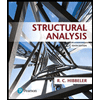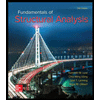Well, that design isn't going to work, either. I think about the only thing I can do is to try to change the concentration of the stream that is leaving Earle Hall. I need my recycle stream to contain 99% of the acetone that leaves Earle, and have a mass% of acetone of 95% (or else I can't reuse it), and I need the stream that is sent to the city's sewer to have 1 mass% acetone. What is the mass% of acetone in the stream leaving Earle that makes this possible?
Well, that design isn't going to work, either. I think about the only thing I can do is to try to change the concentration of the stream that is leaving Earle Hall. I need my recycle stream to contain 99% of the acetone that leaves Earle, and have a mass% of acetone of 95% (or else I can't reuse it), and I need the stream that is sent to the city's sewer to have 1 mass% acetone. What is the mass% of acetone in the stream leaving Earle that makes this possible?
Chapter2: Loads On Structures
Section: Chapter Questions
Problem 1P
Related questions
Question
Please solve #3. First 2 parts have been solved

Transcribed Image Text:1. I am designing the waste water treatment center for Earle Hall. The labs use a lot of acetone for
cleaning glassware, which has to be removed from the waste water before it is sent to the city
for further processing. I want to produce one stream that is high-purity acetone, so that the
labs can re-use it. Assume that the stream leaving Earle Hall is 250,000 Ibm every day, and the
stream is 5 mass% acetone in water. I put this stream into a steady-state separator, which
creates one stream which is 95 mass% acetone (and is recycled for use), and one stream which
is 1 mass% acetone (and is sent to the city's sewer system). What will be the flowrate of the
stream to the city sewer?
2. I sent the design for the new waste water treatment center described above to the city, and
someone did a quick calculation which showed that more than 2,000 lbm per day of acetone
would be going into the city sewer. They didn't like the sound of that. So, they added the
requirement that my recycle stream contain 99% of the acetone that was fed to my separator,
and that the system maintains the 1 mass% acetone in the stream sent to the city's sewer
system. What will the flowrate to the city's sewer system be, and what will be the mass% of
acetone in the stream I recycle for use in the labs?
3. Well, that design isn't going to work, either. I think about the only thing I can do is to try to
change the concentration of the stream that is leaving Earle Hall. I need my recycle stream to
contain 99% of the acetone that leaves Earle, and have a mass% of acetone of 95% (or else I
can't reuse it), and I need the stream that is sent to the city's sewer to have 1 mass% acetone.
What is the mass% of acetone in the stream leaving Earle that makes this possible?
Expert Solution
This question has been solved!
Explore an expertly crafted, step-by-step solution for a thorough understanding of key concepts.
This is a popular solution!
Trending now
This is a popular solution!
Step by step
Solved in 2 steps with 3 images

Knowledge Booster
Learn more about
Need a deep-dive on the concept behind this application? Look no further. Learn more about this topic, civil-engineering and related others by exploring similar questions and additional content below.Recommended textbooks for you


Structural Analysis (10th Edition)
Civil Engineering
ISBN:
9780134610672
Author:
Russell C. Hibbeler
Publisher:
PEARSON

Principles of Foundation Engineering (MindTap Cou…
Civil Engineering
ISBN:
9781337705028
Author:
Braja M. Das, Nagaratnam Sivakugan
Publisher:
Cengage Learning


Structural Analysis (10th Edition)
Civil Engineering
ISBN:
9780134610672
Author:
Russell C. Hibbeler
Publisher:
PEARSON

Principles of Foundation Engineering (MindTap Cou…
Civil Engineering
ISBN:
9781337705028
Author:
Braja M. Das, Nagaratnam Sivakugan
Publisher:
Cengage Learning

Fundamentals of Structural Analysis
Civil Engineering
ISBN:
9780073398006
Author:
Kenneth M. Leet Emeritus, Chia-Ming Uang, Joel Lanning
Publisher:
McGraw-Hill Education


Traffic and Highway Engineering
Civil Engineering
ISBN:
9781305156241
Author:
Garber, Nicholas J.
Publisher:
Cengage Learning